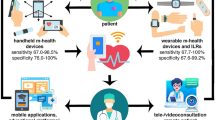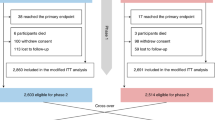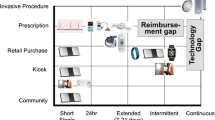Abstract
Atrial fibrillation (AF) will become one of the biggest challenges in cardiovascular medicine in the near future. Attempting an improvement in future patient care calls explicitly for the screening of subclinical AF. Digital health solutions implementing communication technologies for the collection and analysis of digitally assessable data will most likely serve this need. Several new rapidly developing methods were introduced in the past decade. Although the vast majority still require scientific validation, the body of evidence is growing and several randomized controlled trials are planned. This review aims to give an overview of current technologies with a specific focus on mobile health (mHealth) and appraise their value with regard to the available scientific data.
Zusammenfassung
Vorhofflimmern (VHF) wird in absehbarer Zeit zu einer der größten Herausforderungen in der kardiovaskulären Medizin werden. Der Versuch einer Verbesserung der künftigen Patientenversorgung verlangt insbesondere nach einer besseren Früherkennung von subklinischem VHF. Digitale Gesundheitslösungen, die moderne Kommunikationstechnologien zur Sammlung und Analyse von Daten einsetzen, werden bei der Lösung dieses Problems eine maßgebliche Rolle spielen. In der letzten Dekade wurden bereits einige sich schnell weiterentwickelnde Technologien vorgestellt. Wenngleich die Mehrheit weiterhin einer externen Validierung bedarf, wächst die Zahl wissenschaftlicher Publikationen stetig; zudem sind einige randomisierte, kontrollierte Studien in Planung. Dieser Übersichtsartikel soll einen Überblick über aktuell verfügbare digitale Gesundheitsanwendungen mit besonderem Fokus auf sog. „mobile health“(mHealth)-Lösungen geben und deren Nutzen vor dem Hintergrund der verfügbaren Studiendaten bewerten.

Similar content being viewed by others
References
Benjamin EJ, Muntner P, Alonso A et al (2019) Heart disease and stroke statistics-2019 update: a report from the American heart association. Circulation 139(10):e56–e528. https://doi.org/10.1161/CIR.0000000000000659
Di Carlo A, Zaninelli A, Mori F et al (2020) Prevalence of atrial fibrillation subtypes in Italy and projections to 2060 for Italy and Europe. J Am Geriatr Soc 68(11):2534–2541. https://doi.org/10.1111/jgs.16748
Krijthe BP, Kunst A, Benjamin E et al (2013) Projections on the number of individuals with atrial fibrillation in the European Union, from 2000 to 2060. Eur Heart J 34(35):2746–2751. https://doi.org/10.1093/eurheartj/eht280
Boriani G, Laroche C, Diemberger I et al (2015) Asymptomatic atrial fibrillation: clinical correlates, management, and outcomes in the EORP-AF pilot general registry. Am J Med 128(5):509–18.e2. https://doi.org/10.1016/j.amjmed.2014.11.026
Potpara TS, Polovina MM, Marinkovic JM, Lip GY (2013) A comparison of clinical characteristics and long-term prognosis in asymptomatic and symptomatic patients with first-diagnosed atrial fibrillation: the Belgrade atrial fibrillation study. Int J Cardiol 168(5):4744–4749. https://doi.org/10.1016/j.ijcard.2013.07.234
Siontis KC, Gersh BJ, Killian JM et al (2016) Typical, atypical, and asymptomatic presentations of new-onset atrial fibrillation in the community: characteristics and prognostic implications. Heart Rhythm 13(7):1418–1424. https://doi.org/10.1016/j.hrthm.2016.03.003
Jaakkola J, Mustonen P, Kiviniemi T et al (2016) Stroke as the first manifestation of atrial fibrillation. PLoS ONE 11(12):e168010. https://doi.org/10.1371/journal.pone.0168010
Lubitz SA, Yin X, McManus DD et al (2017) Stroke as the initial manifestation of atrial fibrillation: the Framingham heart study. Stroke 48(2):490–492. https://doi.org/10.1161/STROKEAHA.116.015071
Thind M, Holmes DN, Badri M et al (2018) Embolic and other adverse outcomes in symptomatic versus asymptomatic patients with atrial fibrillation (from the ORBIT-AF registry). Am J Cardiol 122(10):1677–1683. https://doi.org/10.1016/j.amjcard.2018.07.045
Melis F, Guido M, Amellone C et al (2021) Prevalence and predictors of atrial fibrillation in patients with embolic stroke of undetermined source: a real-life single-center retrospective study. Neurol Sci. https://doi.org/10.1007/s10072-020-04963-9
Kitsiou A, Rogalewski A, Kalyani M et al (2021) Atrial fibrillation in patients with embolic stroke of undetermined source during 3 years of prolonged monitoring with an Implantable loop recorder. Thromb Haemost. https://doi.org/10.1055/a-1346-2899
Diederichsen SZ, Haugan KJ, Kronborg C et al (2020) Comprehensive evaluation of rhythm monitoring strategies in screening for atrial fibrillation: insights from patients at risk monitored long term with an Implantable loop recorder. Circulation 141(19):1510–1522. https://doi.org/10.1161/CIRCULATIONAHA.119.044407
Guk K, Han G, Lim J et al (2019) Evolution of wearable devices with real-time disease monitoring for personalized healthcare. Nanomaterials. https://doi.org/10.3390/nano9060813
Varma N, Cygankiewicz I, Turakhia MP et al (2021) 2021 ISHNE/HRS/EHRA/APHRS expert collaborative statement on mhealth in arrhythmia management: digital medical tools for heart rhythm professionals: from the international society for Holter and Noninvasive Electrocardiology/heart rhythm society/European heart rhythm association/asia-pacific heart rhythm society. Circ Arrhythm Electrophysiol. https://doi.org/10.1161/CIRCEP.120.009204
Li KHC, White FA, Tipoe T et al (2019) The current state of mobile phone apps for monitoring heart rate, heart rate variability, and atrial fibrillation: narrative review. JMIR Mhealth Uhealth 7(2):e11606. https://doi.org/10.2196/11606
Cotter PE, Martin PJ, Ring L et al (2013) Incidence of atrial fibrillation detected by implantable loop recorders in unexplained stroke. Neurology 80(17):1546–1550. https://doi.org/10.1212/WNL.0b013e31828f1828
Gersak B, Pernat A, Robic B, Sinkovec M (2012) Low rate of atrial fibrillation recurrence verified by implantable loop recorder monitoring following a convergent epicardial and endocardial ablation of atrial fibrillation. J Cardiovasc Electrophysiol 23(10):1059–1066. https://doi.org/10.1111/j.1540-8167.2012.02355.x
Israel C, Kitsiou A, Kalyani M et al (2017) Detection of atrial fibrillation in patients with embolic stroke of undetermined source by prolonged monitoring with implantable loop recorders. Thromb Haemost 117(10):1962–1969. https://doi.org/10.1160/TH17-02-0072
Kapa S, Epstein AE, Callans DJ et al (2013) Assessing arrhythmia burden after catheter ablation of atrial fibrillation using an implantable loop recorder: the ABACUS study. J Cardiovasc Electrophysiol 24(8):875–881. https://doi.org/10.1111/jce.12141
Sanna T, Diener HC, Passman RS et al (2014) Cryptogenic stroke and underlying atrial fibrillation. N Engl J Med 370(26):2478–2486. https://doi.org/10.1056/NEJMoa1313600
Toni D, Lorenzano S, Strano S et al (2016) Detection of Silent Atrial Fibrillation aFter ischemic StrOke (SAFFO) guided by implantable loop recorder: multicentre Italian trial based on stroke unit network with paired cardio-arrhythmology units (Italian neurocardiology unit network). Int J Stroke 11(3):361–367. https://doi.org/10.1177/1747493016631356
Francisco-Pascual J, Olivella San Emeterio A, Rivas-Gandara N et al (2020) High incidence of subclinical atrial fibrillation in patients with syncope monitored with implantable cardiac monitor. Int J Cardiol 316:110–116. https://doi.org/10.1016/j.ijcard.2020.05.078
Healey JS, Alings M, Ha A et al (2017) Subclinical atrial fibrillation in older patients. Circulation 136(14):1276–1283. https://doi.org/10.1161/CIRCULATIONAHA.117.028845
Philippsen TJ, Christensen LS, Hansen MG et al (2017) Detection of subclinical atrial fibrillation in high-risk patients using an Insertable cardiac monitor. JACC Clin Electrophysiol 3(13):1557–1564. https://doi.org/10.1016/j.jacep.2017.06.020
Reiffel JA, Verma A, Kowey PR et al (2017) Incidence of previously undiagnosed atrial fibrillation using insertable cardiac monitors in a high-risk population: the REVEAL AF study. JAMA Cardiol 2(10):1120–1127. https://doi.org/10.1001/jamacardio.2017.3180
Diederichsen SZ, Haugan KJ, Kober L et al (2017) Atrial fibrillation detected by continuous electrocardiographic monitoring using implantable loop recorder to prevent stroke in individuals at risk (the LOOP study): rationale and design of a large randomized controlled trial. Am Heart J 187:122–132. https://doi.org/10.1016/j.ahj.2017.02.017
Turakhia MP, Hoang DD, Zimetbaum P et al (2013) Diagnostic utility of a novel leadless arrhythmia monitoring device. Am J Cardiol 112(4):520–524. https://doi.org/10.1016/j.amjcard.2013.04.017
Turakhia MP, Ullal AJ, Hoang DD et al (2015) Feasibility of extended ambulatory electrocardiogram monitoring to identify silent atrial fibrillation in high-risk patients: the screening study for undiagnosed atrial fibrillation (STUDY-AF). Clin Cardiol 38(5):285–292. https://doi.org/10.1002/clc.22387
Barrett PM, Komatireddy R, Haaser S et al (2014) Comparison of 24-hour Holter monitoring with 14-day novel adhesive patch electrocardiographic monitoring. Am J Med 127(1):95e11–97. https://doi.org/10.1016/j.amjmed.2013.10.003
Rooney MR, Soliman EZ, Lutsey PL et al (2019) Prevalence and characteristics of subclinical atrial fibrillation in a community-dwelling elderly population: the ARIC study. Circ Arrhythm Electrophysiol 12(10):e7390. https://doi.org/10.1161/CIRCEP.119.007390
Eysenck W, Freemantle N, Sulke N (2020) A randomized trial evaluating the accuracy of AF detection by four external ambulatory ECG monitors compared to permanent pacemaker AF detection. J Interv Card Electrophysiol 57(3):361–369. https://doi.org/10.1007/s10840-019-00515-0
Pagola J, Juega J, Francisco-Pascual J et al (2018) Yield of atrial fibrillation detection with textile wearable Holter from the acute phase of stroke: pilot study of crypto-AF registry. Int J Cardiol 251:45–50. https://doi.org/10.1016/j.ijcard.2017.10.063
Paradiso R, Loriga G, Taccini N (2005) A wearable health care system based on knitted integrated sensors. IEEE Trans Inf Technol Biomed 9(3):337–344. https://doi.org/10.1109/titb.2005.854512
Brasier N, Raichle CJ, Dorr M et al (2019) Detection of atrial fibrillation with a smartphone camera: first prospective, international, two-centre, clinical validation study (DETECT AF PRO). Europace 21(1):41–47. https://doi.org/10.1093/europace/euy176
Jacobs MS, Kaasenbrood F, Postma MJ et al (2018) Cost-effectiveness of screening for atrial fibrillation in primary care with a handheld, single-lead electrocardiogram device in the Netherlands. Europace 20(1):12–18. https://doi.org/10.1093/europace/euw285
Orchard J, Lowres N, Freedman SB et al (2016) Screening for atrial fibrillation during influenza vaccinations by primary care nurses using a smartphone electrocardiograph (iECG): a feasibility study. Eur J Prev Cardiol 23(2):13–20. https://doi.org/10.1177/2047487316670255
Vaes B, Stalpaert S, Tavernier K et al (2014) The diagnostic accuracy of the MyDiagnostick to detect atrial fibrillation in primary care. BMC Fam Pract 15:113. https://doi.org/10.1186/1471-2296-15-113
William AD, Kanbour M, Callahan T et al (2018) Assessing the accuracy of an automated atrial fibrillation detection algorithm using smartphone technology: the iREAD study. Heart Rhythm 15(10):1561–1565. https://doi.org/10.1016/j.hrthm.2018.06.037
Halcox JPJ, Wareham K, Cardew A et al (2017) Assessment of remote heart rhythm sampling using the AliveCor heart monitor to screen for atrial fibrillation: the REHEARSE-AF study. Circulation 136(19):1784–1794. https://doi.org/10.1161/CIRCULATIONAHA.117.030583
Diederichsen SZ, Haugan KJ, Brandes A et al (2020) Incidence and predictors of atrial fibrillation episodes as detected by implantable loop recorder in patients at risk: from the LOOP study. Am Heart J 219:117–127. https://doi.org/10.1016/j.ahj.2019.09.009
Quer G, Freedman B, Steinhubl SR (2020) Screening for atrial fibrillation: predicted sensitivity of short, intermittent electrocardiogram recordings in an asymptomatic at-risk population. Europace 22(12):1781–1787. https://doi.org/10.1093/europace/euaa186
Mc MD, Chong JW, Soni A et al (2016) PULSE-SMART: pulse-based arrhythmia discrimination using a novel smartphone application. J Cardiovasc Electrophysiol 27(1):51–57. https://doi.org/10.1111/jce.12842
Verbrugge FH, Proesmans T, Vijgen J et al (2019) Atrial fibrillation screening with photo-plethysmography through a smartphone camera. Europace 21(8):1167–1175. https://doi.org/10.1093/europace/euz119
O’Sullivan JW, Grigg S, Crawford W et al (2020) Accuracy of smartphone camera applications for detecting atrial fibrillation: a systematic review and meta-analysis. JAMA Netw Open 3(4):e202064. https://doi.org/10.1001/jamanetworkopen.2020.2064
Bonomi AG, Schipper F, Eerikainen LM et al (2018) Atrial fibrillation detection using a novel cardiac ambulatory monitor based on photo-plethysmography at the wrist. J Am Heart Assoc 7(15):e9351. https://doi.org/10.1161/JAHA.118.009351
Dorr M, Nohturfft V, Brasier N et al (2019) The WATCH AF trial: SmartWATCHes for detection of atrial fibrillation. JACC Clin Electrophysiol 5(2):199–208. https://doi.org/10.1016/j.jacep.2018.10.006
Guo Y, Wang H, Zhang H et al (2019) Mobile photoplethysmographic technology to detect atrial fibrillation. J Am Coll Cardiol 74(19):2365–2375. https://doi.org/10.1016/j.jacc.2019.08.019
Perez MV, Mahaffey KW, Hedlin H et al (2019) Large-scale assessment of a smartwatch to identify atrial fibrillation. N Engl J Med 381(20):1909–1917. https://doi.org/10.1056/NEJMoa1901183
Tison GH, Sanchez JM, Ballinger B et al (2018) Passive detection of atrial fibrillation using a commercially available smartwatch. JAMA Cardiol 3(5):409–416. https://doi.org/10.1001/jamacardio.2018.0136
Bumgarner JM, Lambert CT, Hussein AA et al (2018) Smartwatch algorithm for automated detection of atrial fibrillation. J Am Coll Cardiol 71(21):2381–2388. https://doi.org/10.1016/j.jacc.2018.03.003
Chen E, Jiang J, Su R et al (2020) A new smart wristband equipped with an artificial intelligence algorithm to detect atrial fibrillation. Heart Rhythm 17(5):847–853. https://doi.org/10.1016/j.hrthm.2020.01.034
Seshadri DR, Bittel B, Browsky D et al (2020) Accuracy of apple watch for detection of atrial fibrillation. Circulation 141(8):702–703. https://doi.org/10.1161/CIRCULATIONAHA.119.044126
Wasserlauf J, You C, Patel R et al (2019) Smartwatch performance for the detection and quantification of atrial fibrillation. Circ Arrhythm Electrophysiol 12(6):e6834. https://doi.org/10.1161/CIRCEP.118.006834
Couderc JP, Kyal S, Mestha LK et al (2015) Detection of atrial fibrillation using contactless facial video monitoring. Heart Rhythm 12(1):195–201. https://doi.org/10.1016/j.hrthm.2014.08.035
Yan BP, Lai WHS, Chan CKY et al (2018) Contact-free screening of atrial fibrillation by a smartphone using facial pulsatile photoplethysmographic signals. J Am Heart Assoc. https://doi.org/10.1161/JAHA.118.008585
Yan BP, Lai WHS, Chan CKY et al (2020) High-throughput, contact-free detection of atrial fibrillation from video with deep learning. JAMA Cardiol 5(1):105–107. https://doi.org/10.1001/jamacardio.2019.4004
Hill NR, Ayoubkhani D, McEwan P et al (2019) Predicting atrial fibrillation in primary care using machine learning. PLoS ONE 14(11):e224582. https://doi.org/10.1371/journal.pone.0224582
Sekelj S, Sandler B, Johnston E et al (2020) Detecting undiagnosed atrial fibrillation in UK primary care: validation of a machine learning prediction algorithm in a retrospective cohort study. Eur J Prev Cardiol. https://doi.org/10.1177/2047487320942338
Tiwari P, Colborn KL, Smith DE et al (2020) Assessment of a machine learning model applied to harmonized electronic health record data for the prediction of incident atrial fibrillation. JAMA Netw Open 3(1):e1919396. https://doi.org/10.1001/jamanetworkopen.2019.19396
Hill NR, Arden C, Beresford-Hulme L et al (2020) Identification of undiagnosed atrial fibrillation patients using a machine learning risk prediction algorithm and diagnostic testing (PULsE-AI): study protocol for a randomised controlled trial. Contemp Clin Trials 99:106191. https://doi.org/10.1016/j.cct.2020.106191
Attia ZI, Noseworthy PA, Lopez-Jimenez F et al (2019) An artificial intelligence-enabled ECG algorithm for the identification of patients with atrial fibrillation during sinus rhythm: a retrospective analysis of outcome prediction. Lancet 394(10201):861–867. https://doi.org/10.1016/S0140-6736(19)31721-0
Raghunath S, Pfeifer JM, Ulloa-Cerna AE et al (2021) Deep neural networks can predict new-onset atrial fibrillation from the 12-lead electrocardiogram and help identify those at risk of AF-related stroke. Circulation. https://doi.org/10.1161/CIRCULATIONAHA.120.047829
Hindricks G, Potpara T, Dagres N et al (2021) 2020 ESC guidelines for the diagnosis and management of atrial fibrillation developed in collaboration with the European association for cardio-thoracic surgery (EACTS). Eur Heart J 42(5):373–498. https://doi.org/10.1093/eurheartj/ehaa612
Author information
Authors and Affiliations
Corresponding author
Ethics declarations
Conflict of interest
S. König, A. Bollmann, and G. Hindricks declare that they have no competing interests.
For this article no studies with human participants or animals were performed by any of the authors. All studies performed were in accordance with the ethical standards indicated in each case.
Rights and permissions
About this article
Cite this article
König, S., Bollmann, A. & Hindricks, G. Digital health solutions in the screening of subclinical atrial fibrillation. Herz 46, 329–335 (2021). https://doi.org/10.1007/s00059-021-05041-2
Accepted:
Published:
Issue Date:
DOI: https://doi.org/10.1007/s00059-021-05041-2




